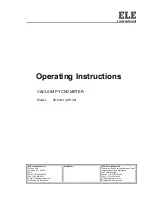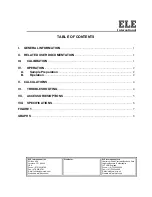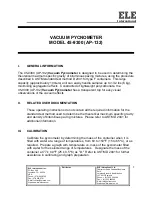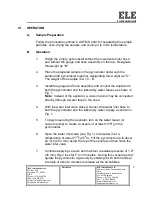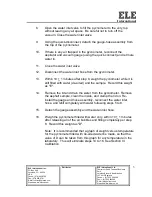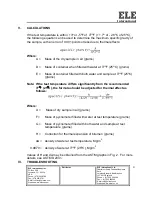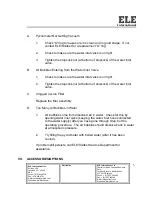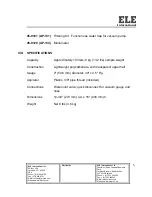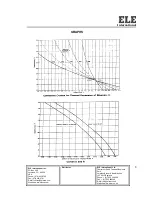
International
ELE International, Inc.
PO Box 608
Loveland, CO 80539
USA
Phone: (970) 663-9780
Fax: (970) 663-9781
E-Mail: [email protected]
Website: www.eleusa.com
Distributor: ELE
International,
Ltd.
Chartmoor Road Chartwell Business
Park
Leighton Buzzard, Bedfordshire
LU7 4WG England
Phone: + (0) 1525 249200
Fax: + (0) 1525 249249
E-Mail: [email protected]
Website: www.eleint.co.uk
2
IV. OPERATION
A. Sample
Preparation
Follow the procedure outlined in ASTM D 2041 for separating the sample
particles, oven-drying the sample, and cooling it to room temperature.
B. Operation
1.
Weigh the empty pycnometer without the lower water inlet hose
and without the gauge and hose assembly on the top. Designate
this weight as "B."
2.
Place the prepared sample in the pycnometer and weigh the
sample and pycnometer together, designating this weight as "C."
The weight of the sample is A = C - B.
3.
Install the gauge and hose assembly and connect the aspirator to
both the pycnometer and the laboratory water faucet, as shown in
Fig. 1.
Note: Instead of the aspirator, a vacuum pump may be connected
directly (through a water trap) to the hose.
4.
With the water inlet valve closed, connect the water inlet hose to
both the pycnometer and the laboratory water supply, as shown in
Fig. 1.
5.
To begin operating the aspirator, turn on the water faucet (or
vacuum pump) to create a vacuum of at least 10" Hg in the
pycnometer.
6.
Open the water inlet valve (see Fig. 1) to let water in at a
temperature of about 77
o
F (25
o
C). Fill the pycnometer up to about
an inch (25.4 mm) below the top of the sphere and then close the
water inlet valve.
7.
Continue applying vacuum and maintain a residual pressure of 1.2"
(30 mm) Hg or less for 5 to 15 minutes. During this vacuum period,
agitate the pycnometer vigorously by shaking it with both hands at
intervals of about 2 minutes to release all the air bubbles.

